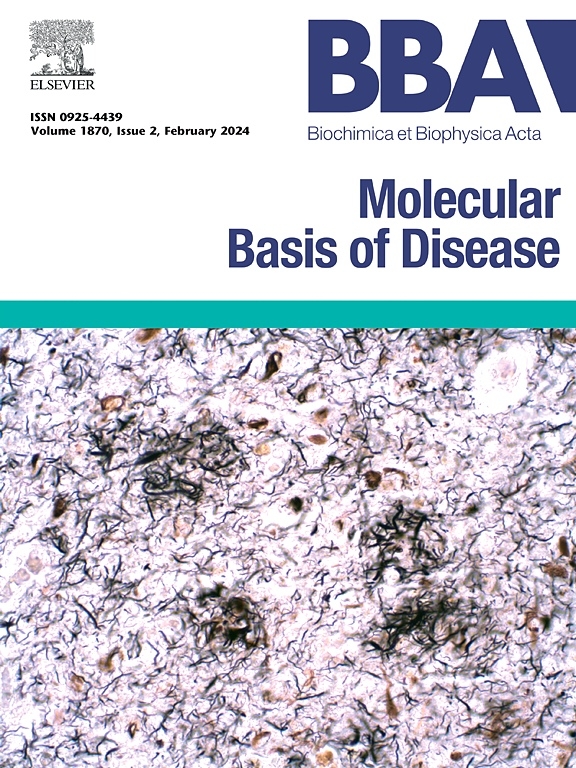Amylin is incorporated into extracellular vesicles in an ESCRT-dependent manner and regulates senescence
IF 4.2
2区 生物学
Q2 BIOCHEMISTRY & MOLECULAR BIOLOGY
Biochimica et biophysica acta. Molecular basis of disease
Pub Date : 2025-01-30
DOI:10.1016/j.bbadis.2025.167699
引用次数: 0
Abstract
Type 2 diabetes mellitus is a disease which initiates with insulin resistance. Then, pancreatic β cells start to counteract this situation by increasing insulin secretion, which is known as pre-diabetic state. Amylin protein or islet amyloid polypeptide (IAPP), has multiple physiological roles such as the regulation of satiety and avoiding gastric emptying. However, amylin is able to aggregate, forming insoluble structures that affects pancreatic β cell survival. Interestingly, not all the amylin from the different species has this aggregate-prone capacity. There are species, which possesses non-amyloidogenic capacity and does not aggregate such as the rodents. However, there are versions of the protein, for instance from humans and primates, which can aggregate. Previously, we observed that small oligomers could be found in extracellular vesicles (EVs). Now, we have used a pancreatic β cell which overexpresses human amylin (hIAPP) (INS1E-hIAPP) and we have explored the capacity of amylin to be incorporated into EVs and how amylin could affect to different essential signaling pathways such as the mammalian target of rapamycin complex 1, endoplasmic-reticulum stress and senescence. Here, we report that amylin can be incorporated into EVs in an endosomal sorting complexes required for transport (ESCRT)-dependent manner. When we treated the cells with the neutral sphingomyelinase inhibitor, GW4869, one of the pathways for EV biogenesis and under high glucose conditions, there was an increased incorporation of soluble amylin into vesicles. Interestingly in this condition, when we isolated the EVs, we clearly observed that the size of the vesicles was higher, compatible with microvesicles (MVs). Resveratrol increased a pro-senescent phenotype but, it was able to revert either the high glucose or GW4869-associated senescent. In summary, these results indicate that amylin can be recruited in an ESCRT-dependent manner into EVs and, resveratrol presents an important role in inducing senescence in INS1E-hIAPP pancreatic β cells.
求助全文
约1分钟内获得全文
求助全文
来源期刊
CiteScore
12.30
自引率
0.00%
发文量
218
审稿时长
32 days
期刊介绍:
BBA Molecular Basis of Disease addresses the biochemistry and molecular genetics of disease processes and models of human disease. This journal covers aspects of aging, cancer, metabolic-, neurological-, and immunological-based disease. Manuscripts focused on using animal models to elucidate biochemical and mechanistic insight in each of these conditions, are particularly encouraged. Manuscripts should emphasize the underlying mechanisms of disease pathways and provide novel contributions to the understanding and/or treatment of these disorders. Highly descriptive and method development submissions may be declined without full review. The submission of uninvited reviews to BBA - Molecular Basis of Disease is strongly discouraged, and any such uninvited review should be accompanied by a coverletter outlining the compelling reasons why the review should be considered.

 求助内容:
求助内容: 应助结果提醒方式:
应助结果提醒方式:


